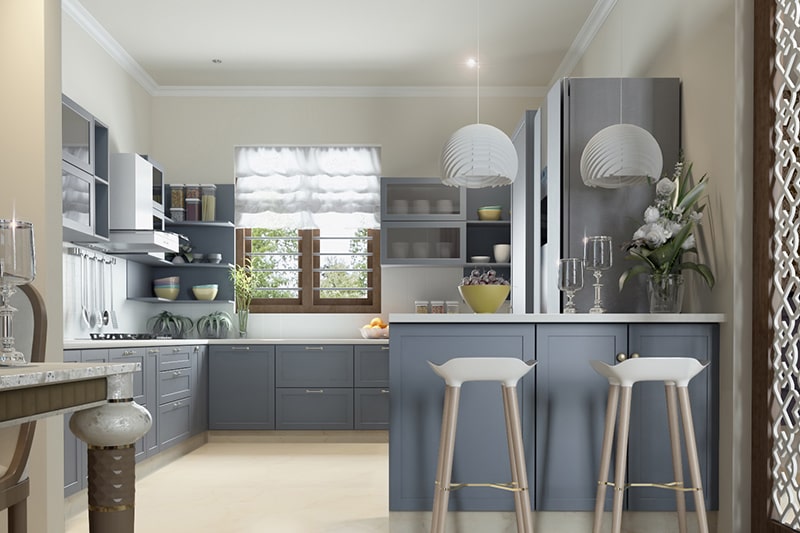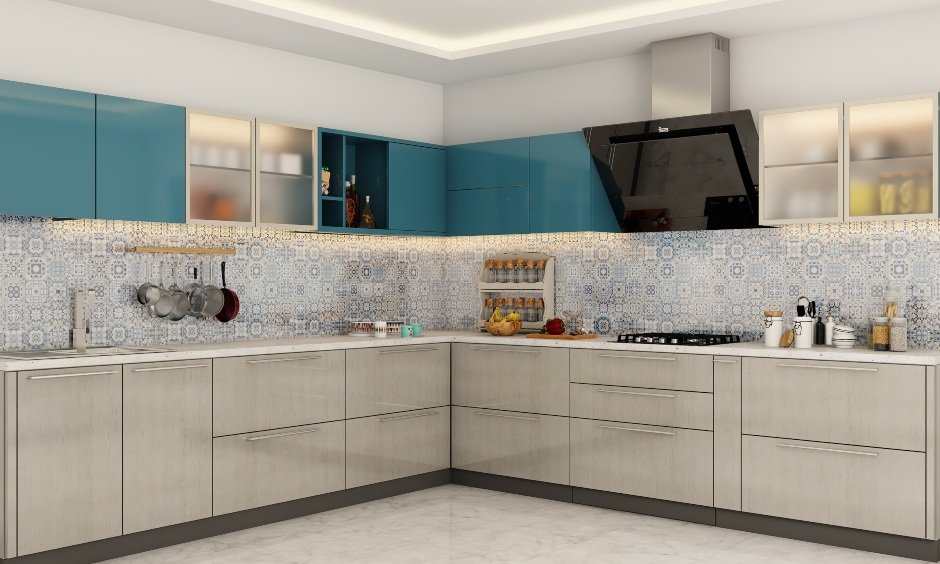Kitchen false ceilings make cooking spaces look and feel good, perfect for entertaining and family get-togethers.
Walk into a home and it is as though everything in home design is centred around the living space. From elaborate wallpapers to carved furniture, mantle pieces and false ceilings, homeowners do not spare any cost or creativity in doing up living rooms. As we move further inside, the design elements reduce and utilitarian value of the space takes precedence. It is therefore often found that kitchens are the least designed space in the home. The focus is more on storage, cabinets and drawers than anything else. But with more time spent in modern kitchens, these too are undergoing a makeover. It is therefore no surprise that kitchen false ceilings are becoming increasingly popular, and you as a homeowner must think of designing one for yourself in your home.
Designing kitchen false ceilings are a little different when compared with the rest of the home. Unlike living and dining areas, where it is all about the look and design complementing your furniture, kitchens have a basic function – cooking. The design, materials have to be done in keeping with this use. It is like the storage case of a guitar, made to fit with the instrument’s needs and not just aesthetics.
What Are False Ceilings?
False ceilings conceal a great variety of things – electrical wiring and AC regulators, pipes and exposed concrete. They are both decorative and functional, energy efficient and fire safe, sound proof and sag resistant. In the short run, they lend beautiful aesthetics, but in the long term protect your home from damage. Among most rooms in the home, kitchens are a place that absolutely require them.
Kitchens are the most important space in a home, and yet we often leave them bare, basic and unsightly. Investing in a good kitchen ceiling really lifts up the mood and shows the importance of it for a family. Below are a few ideas compiled based on the kind of material used, and the design that best suits a kitchen based on the size available.
Simple False Ceiling Designs For Kitchen
It is often misconstrued that false ceilings have to be ornate and elaborate with lots of hidden lighting, to make a room really stand out. On the contrary false ceilings are done to protect the ceiling from wear and tear, keep away dampness and collection of moisture as well as to lift aesthetics. A simple design can be a one with basic hidden lighting and using materials like wood or gypsum. The design isn’t elaborate and yet has a neat, finished look. Instead of the traditional lighting fixtures and tubes, a few high quality, low-energy LED lights can do so much for lighting in the home. In case of a home with over-draughts and extreme cold, false ceilings also provide thermal insulation and are great to have if kitchens become too hot and stuffy.

Small Kitchen Ceiling Design
Small kitchens have compromised spaces, and it might seem futile to get a false ceiling in there. But these false ceilings surprisingly level off temperature and do away with the need for chimneys. The air-filled gap between layers of the ceiling cools down the room, traps moisture and heat and displaces it around. Small kitchens work best with wood or fibre for the material’s lightness. The only trick to ensuring materials last is by using water-resistant finishes as much as possible.

Kitchen POP Ceiling Design
Plaster of Paris is a material used since decades to design false walls and ceilings. It is also fairly common in most homes. Cheap, malleable and attractive nonetheless, it also takes up different colors. POP is mixed with water and applied to a wooden base or fibreboard for shape after suspending from the ceiling. Because it isn’t pre-fabricated, it needs artistic workmanship and real skill to create. POP false ceilings have a few unique traits well suited for kitchens. They give a smooth finish and can be painted over or customised, are lightweight and with a thickness of 12-15 mm. They’re also better suited for large and more elaborate spaces.

Luxury Modular Kitchen Designs
Modern Kitchen False Ceiling
Modern homes are no longer restricted to specific designs and themes. As varied as the themes, so are the endless possibilities of creativity and imagination. Whether minimalist or contemporary, luxurious or subtle, there’s plenty of scope for experimentation. An ornate ceiling with plenty of hidden lighting works beautifully to enhance luxury. Similarly a simpler visually appealing design in ceiling may convey something altogether different. What matters in modern kitchen false ceilings is the kind of material used. Wood which is more traditional is being used in innovative and contemporary ways to design kitchen ceilings reminiscent of days of old. These come complete with beams and slats, insulation and lighting. Metal panels are more modern and minimal. Clean lines, easy to install and monolithic designs make them attractive, but kitchen heat can be unbearable. Even so, many modern kitchens seem to be trying out this and other varieties of materials.

PVC Ceiling Designs For Kitchen
Ceiling claddings in PVC (polyvinyl chloride) are popular and increasingly being used as alternatives to POP. Strong, lightweight plastic that can be premade and pre-fabricated in a custom design and colours, they are ready in panels with a hollow core and smooth surface. Their waterproofed surfaces make them ideal for kitchens and are considered by many homeowners as a viable substitute for gypsum and POP in moisture laden kitchens and even bathrooms. Durable, affordable and sturdy, PVA can be made to look by you as simple or elegant as you like and getting them up is just as easy. They discourage mould and dampness and you’ll take much less time cleaning them. On the flip side PVC can be a deterrent where food is prepared in kitchens.

Kitchen Gypsum Ceiling Design
Gypsum board is quintessential ceiling material. Commonly used, carved as per the design in tapered or square edges, they can be easily fixed with nailing or placed over a metal grid. They are lightweight, disperse light easily and lend just the right color to kitchen spaces. Gypsum is also waterproof and given the amount of cooking that happens, is perhaps best for kitchens in apartments these days.

As a homeowner you’d love for your entire kitchen space to look and feel beautiful, without compromise on the quality of work or the food you prepared. A few things to keep in mind will include:
- Choose material that suits the function of your kitchen. One that is constantly in use will need false ceiling materials that can withstand the heat and not cause toxicity.
- Keep design simple and functional. More elaborate the design, more the maintenance work required to ensure it stays clean and hygienic at all times
- Design well-balanced and optimal lighting into the false ceiling. With a big purpose of false ceilings being having good lighting, it is essential to plan the way this is done. Edging lighting and a focus on the cooking area defines the purpose of having them
- Segregate areas with emphasis on false ceilings. Modern kitchens have separate islands and breakfast areas and building in good lighting and ventilation into them can be complex but a process that must be undertaken at the start.
Well designed kitchen false ceilings can make the cooking area stuffy or unpleasant, beautiful or an eyesore. Once done, they cannot be wished away. Before embarking on any ideas it is better to think well, plan in-depth and then take the plunge in installing an optimal false ceiling for the kitchen you’ll be spending lots of time and cooking in.
Also Read:
- Best False Ceiling Designs For Bedroom
- Latest False Ceiling Designs For Hall
- 10 Best False Ceiling Light Designs For Home
- False Ceiling Design Ideas For Living Room
- Innovative Modular Kitchen Designs
 Select Category
Select Category





















